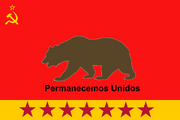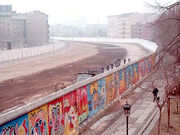Eureka! (Ancient Greek) | |||||||
| Anthem | "California, I love thee!" | ||||||
| Capital | San Francisco | ||||||
| Largest city | Los Angeles | ||||||
| Other cities | Las Vegas, Phoenix, San Diego, Salt Lake City, Reno, Sacramento and Roswell | ||||||
| Language official |
English, Spanish | ||||||
| others | Japanese, Tagalog, Korean, Chumash and other Native American languages. | ||||||
| Religion | Roman Catholicism, Atheism, Mormonism and Shinto/Japanese folk religions | ||||||
| Demonym | Californian | ||||||
| Government | Semi-Presidential Federal Republic | ||||||
| Legislature | Senate of California | ||||||
| President | Gavin Newsom | ||||||
| Prime Minister | Willie Brown | ||||||
| Population | 54,964,625 | ||||||
| Established | 1836 | ||||||
| Independence | from Mexican Empire | ||||||
| declared | 1836 | ||||||
| recognized | 1837 | ||||||
| Currency | Californian Dollar | ||||||
| Internet TLD | .ca | ||||||
| Organizations | Union of Nations, Pacific Free Trade Union | ||||||
History[]
The Republic of California was founded on October 4th, 1836, in response to the Mexican invasion of another rebellious state, Texas. The Californian and Texan Governments gained support from the British and American governments, Britain landed troops in Yucatan via Beleize and seized vital ammunition shipments while Mexican President Santa Anna was captured in trying to flee from Texas.
Mexico was forced to recognize the sovereignty of the Republics of Texas and California. The two nations fell under British influence for a while, before breaking away from the British sphere of influence. Due to its position in North America, being faced with the almighty Pacific Ocean, California had a huge influx of immigrants in the mid 1800s to the early 1900s as trade with Japan and China boomed.
Communalist Government[]

Flag of the Communalist regime (1936-1992)
In the mid 1930s, the Californian Communalist Party won by a landslide. The New government didn't hesitate in industrialising the nation ad setting up collective farms. California's Chinese, Japanese and Korean Minorities were scrutinised and were subjected to racist policies, similar to New Frieslands's policy of Apartheid.
The United States, fearing Communalist uprisings in their own Nation, built a huge border fence to keep the Cali's out and Yankees in. Surprisingly, the Californian government distanced themselves from Germany, after the Cali-German Split that resulted in North Nippon and California leaving the Warsaw Pact in the 1960s and joining the Non Aligned Movement.
Collapse of the Regime and Post Cold War Boom[]
In 1993, the Communalist Party was on its last legs, the younger, more liberal-minded politicians clashed with the older reactionaries, the people wanted change, and they go it. The last Communalist President, Jerry Brown, allowed free elections and lifted restrictions on Asian-American rights. To signify the end of an era, the 'Red Bear' was lowered at the Californian Federal parliament building on December 12th, 1993.
After the official end of Communalist rule in early 1994, the Californian Liberal Party won in a landslide. The nation lifted many restrictions on certain minority groups, the most controversial was allowing homosexuals to marry, making California the first nation in the Americas, and the world, to do so, other nations like the Netherlands and Scandinavia following months later.
US President Bill Clinton and Californian President Pete Wilson met in 1996 to discuss the dismantling of the Californian Wall, which was originally promised in the late 1980s, when US President Regan urged for California to reopen trade between the two Nations. The two Presidents symbolically shook hands through the hole that was ripped through the wall separating the United States and California. Both governments reopened their embassies in Philadelphia and San Francisco a few days later and diplomatic relations have been high ever since.

A Section of the California Wall, circa 1976
California had always been known for its vibrant Asian communities in Los Angeles and San Deigo, during the Communalist Regime, Asian-Californians were segregated from society and were treated like second class citizens. President Wilson officially apologised for the harsh treatment in 2000, hoping to further heal the divide between the various communities. Many of the various internment camps are open to the public as museums.



